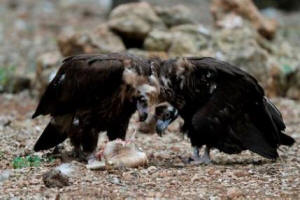|
 One
tough bird: vulture's genes help it thrive on rotting flesh One
tough bird: vulture's genes help it thrive on rotting flesh
 Send a link to a friend
Send a link to a friend
[October 21, 2015]
By Will Dunham
WASHINGTON (Reuters) - A diet of putrid
rotting flesh may not be your cup of tea, but to the cinereous vulture,
found across southern Europe and Asia, it is positively delightful. This
tough bird, it turns out, is genetically wired to thrive on the stuff.
|
|
 Researchers on Tuesday said they have sequenced the genome of this
big scavenger, also called the Eurasian black vulture, identifying
genetic traits that account for a stalwart stomach and powerful
immune system that let it carry on eating carrion. Researchers on Tuesday said they have sequenced the genome of this
big scavenger, also called the Eurasian black vulture, identifying
genetic traits that account for a stalwart stomach and powerful
immune system that let it carry on eating carrion.
They pinpointed genetic features related to gastric acid secretion
that help explain this vulture's ability to digest carcasses and
other features linked to its immune system defense against microbial
and viral infections from decomposing flesh.
"It is known that they are all but immune to botulism and that they
can happily eat the flesh of an animal coated in Bacillus anthracis
that causes anthrax," said geneticist Jong Bhak of South Korea's
Ulsan National Institute of Science and Technology.

"They also are known to take infected food with rabies, hog cholera
and numerous other diseases that would be lethal to most other
scavengers."
This vulture may have the strongest stomach in the world, Bhak said.
"They have an extremely acidic stomach, enough to melt bones and
perhaps metals," Bhak added.
The cinereous vulture, whose scientific name is Aegypius monachus,
can be found in plains, grasslands and mountainous regions from
Spain to South Korea, although its numbers are dangerously low in
parts of its fragmented range.
It is one of the world's largest birds of prey, with a wingspan up
to 10 feet (3 meters). It is clad in dark brown feathers with a pale
head and bluish beak. Its diet consists mostly of the carcasses of
medium and large mammals.
[to top of second column] |

The researchers compared its genome to that of the American bald
eagle, and learned that the two are more closely related than
previously suspected. Bhak said they share a common ancestor that
lived about 18 million years ago.
The cinereous vulture is a member of a group called Old World
vultures found in Europe, Asia and Africa. These birds are distinct
from the New World vultures like the turkey vulture found in the
Americas that live similar lifestyles but are only distantly
related. Bhak said the most recent common ancestor of Old World and
New World vultures lived about 60 million years ago.
The research was published in the journal Genome Biology.
(Reporting by Will Dunham; Editing by Sandra Maler)
[© 2015 Thomson Reuters. All rights
reserved.]
Copyright 2015 Reuters. All rights reserved. This material may not be published,
broadcast, rewritten or redistributed.
 |